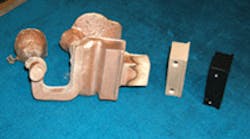Authored by Edited by Leslie Gordon, Resources: |
Today, manufacturing technology includes plenty of high-tech digital prototyping tools such as laser scanners and 3D printers. However, in many situations, manual methods can produce metal parts faster and at a lower cost. For example, a metal casting can generally be produced without the expense of digital prototyping when existing parts or mock-ups already exist.
In one case, a restorer needing a cast-metal part for an antique child’s highchair asked our company what it would take to replicate the part. A few hours later, the restorer walked out of the foundry with the completed part in hand. It had been reproduced quickly, inexpensively, and without the use of digital prototyping.
In fact, we can produce fully functional metal parts in a few hours, at prices as low as $35, and with surface finishes in the 60 to 200-RMS range (equivalent to investment casting at a third of the cost). This kind of production can best be categorized as “artisanal” — it contains handcrafted elements and parts are produced for niche-market quantities (1 to 1,000 pieces in 30 days or less).
In another application, a customer needed 55 lock strikes that would visually and mechanically match existing brass door locks from 1940s Liberty ships. The customer wanted to reuse the door locks in a modern residential application. The shop first defined the 3D shape using a two-piece metal mock-up supplied by the customer. The part needed to be cast hollow and machined to remove the mold draft, so we made a new master to accommodate shrinkage of the metal tooling and casting. We made a master out of wood, wax, and clay in less than an hour.
Next came a “core box” (which lets the casting have a hollow cavity) produced from an existing strike previously made by another manufacturer, a core print (used to hold the core during casting), and a castable two-part plastic. This took about 4 hr of shop time. Next were four patterns for production. We used the master to create a loose-molded green sand mold and poured molten ZA12 (a zinc-aluminum alloy) into it. ZA12, flows well into the mold, machines readily with hand power tools, and produces a durable pattern.
After cleaning up the patterns, we mounted them on a match plate along with rigging for the finished production pattern. Using this match-plate pattern, we cast four strikes in each mold. Production involved pouring molten silicon bronze (a color match with the 1940’s hardware) into the clamped green sand mold. Once the rough castings solidified and cooled, we removed them from the mold and processed them through secondary operations. An outside powder-coater applied the final part finish.
Modern prototyping technology offers exciting new ways of doing things and in many cases can be an efficient method of going from art to part. But access to technology can be expensive so it is often out of reach for individuals needing just one part for an antique chair, or a small part run for the reuse of existing door locks.
In today’s economy, using the right tool for the right job is more important than ever. Many “old-fashioned,” but tried-and-true methods are still valid today. It is likely that a new “Brass Age” will soon give designers more choices and perhaps help change the face of manufacturing. For example, components made from copper-based alloys are the only materials that can continually be recycled in community-supported manufacturing enclaves.
